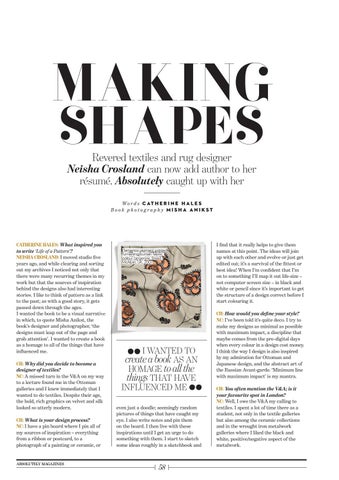MAKING SHAPES Revered textiles and rug designer Neisha Crosland can now add author to her résumé. Absolutely caught up with her W o r d s c at h e r i n e h a l e s Book photography Misha Anikst
CATHERINE HALES: What inspired you to write ‘Life of a Pattern’? NEISHA CROSLAND: I moved studio five years ago, and while clearing and sorting out my archives I noticed not only that there were many recurring themes in my work but that the sources of inspiration behind the designs also had interesting stories. I like to think of pattern as a link to the past; as with a good story, it gets passed down through the ages. I wanted the book to be a visual narrative in which, to quote Misha Anikst, the book’s designer and photographer, ‘the designs must leap out of the page and grab attention’. I wanted to create a book as a homage to all of the things that have influenced me. CH: Why did you decide to become a designer of textiles? NC: A missed turn in the V&A on my way to a lecture found me in the Ottoman galleries and I knew immediately that I wanted to do textiles. Despite their age, the bold, rich graphics on velvet and silk looked so utterly modern. CH: What is your design process? NC: I have a pin board where I pin all of my sources of inspiration – everything from a ribbon or postcard, to a photograph of a painting or ceramic, or
ABSOLUTELY MAGAZINES
SW_Aug2016_NesihaCrosland.indd 58
Flamenco pigment printed furnishing/curtain fabric, colour tangerine, Stead McAlpin, UK, 2007
I WANTED TO create a book AS AN HOMAGE to all the things THAT HAVE INFLUENCED ME even just a doodle; seemingly random pictures of things that have caught my eye. I also write notes and pin them on the board. I then live with these inspirations until I get an urge to do something with them. I start to sketch some ideas roughly in a sketchbook and
I find that it really helps to give them names at this point. The ideas will join up with each other and evolve or just get edited out; it’s a survival of the fittest or best idea! When I’m confident that I’m on to something I’ll map it out life-size – not computer screen size – in black and white or pencil since it’s important to get the structure of a design correct before I start colouring it. CH: How would you define your style? NC: I’ve been told it’s quite deco. I try to make my designs as minimal as possible with maximum impact, a discipline that maybe comes from the pre-digital days when every colour in a design cost money. I think the way I design is also inspired by my admiration for Ottoman and Japanese design, and the abstract art of the Russian Avant-garde. ‘Minimum line with maximum impact’ is my mantra. CH: You often mention the V&A; is it your favourite spot in London? NC: Well, I owe the V&A my calling to textiles. I spent a lot of time there as a student, not only in the textile galleries but also among the ceramic collections and in the wrought iron metalwork galleries where I liked the black and white, positive/negative aspect of the metalwork.
58 29/07/2016 11:21
